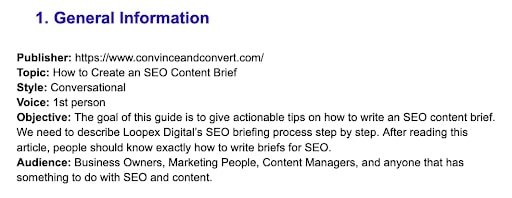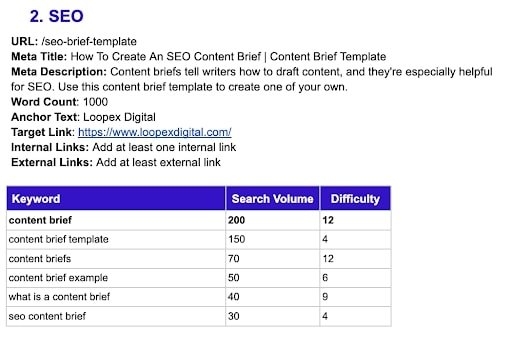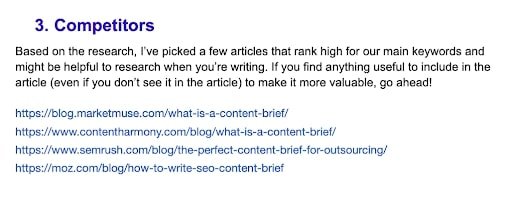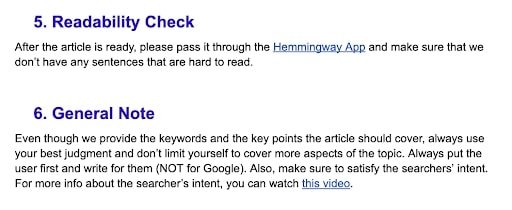Endless revisions. Countless opportunities were lost. Missed deadline after missed deadline.
Does that seem familiar?
Look, my SEO agency had to deal with the same content setbacks, too … until we embraced the SEO content brief and made it our own.
What is a content brief?
A content brief is a document that tells a writer how to draft a piece of content. A “piece of content” in this case could be a blog, product description, service page, landing page, collection page, and so on.
But there’s more than one kind of content brief. For example, an agency drafts a creative brief for their copywriter to make an ad campaign. A high-volume content farm pulls AI-generated briefs for its team of content writers. Or in our case, we thoughtfully (and manually) build SEO content briefs based on keyword research and competitor analysis.
Generally speaking, writers follow SEO content briefs to create content that targets a specific keyword. If executed properly, that content can then earn more organic traffic that’s also highly likely to convert.
SEO content briefs usually include general information about the task (like word count, topic, and so on). But they can also provide more in-depth information about the content’s purpose and even double as a rough outline. We tried both methods and found the latter outperforms the former — more on that shortly.
Why is an SEO content brief important?
Even a barebones SEO content brief is useful because it tells the writer what to write about. Without one, a writer shoots around in the dark and often misses the mark. That’s because not all writers are expert SEOs (and the inverse is also true).
Before we cemented our current process at Whizzystack, our briefs were just a keyword and a word count … and that was it. We noticed writers delivered drafts that weren’t optimized for search engines. The content “spoke” to the wrong audience. And above all, there just wasn’t a clear strategy.
So we learned from this and gave writers a keyword, a word count, and a short description about what the content needed to say. And even though we found the content performed better than before, we wanted content to perform as well as it possibly could.
This process evolved over several iterations into the one we use today. (In fact, it’s the same process I used to write this exact piece of content! Here is the content brief used(Open Link in new window))
Now we provide each writer with a highly detailed, highly structured SEO content brief. Each brief includes a primary keyword, secondary keywords, word count, topic, style, anchor text, target links, a list of competitors, and an article structure. We also provide context, like describing the target audience, keyword intent, and overall objective.
We noticed that when we control SEO, our writers have more space, time, and freedom to control creativity. In the end, each piece of content is optimized for SEO and it’s engaging. Because of this, articles written according to our briefs earn relevant traffic and quality backlinks.
Plus, our well-structured briefs cut down on the back-and-forth between our team, our writers, and our clients. That’s because detailed SEO content briefs set clear expectations for the content. So we end up with fewer revision cycles, fewer rewrites, and fewer missed deadlines.
What to include in an SEO content brief?
Here’s a complete list of everything you need to create your own SEO content brief — including step-by-step guidance and snippets from the brief we used to write this article. You can also use our SEO content brief template(Open Link in new window) for your upcoming projects.
Get our best tips in your inbox! Join the smartest marketers who receive our ON newsletter.
General information
Creative Brief General Information Example

Publisher: Note where the finished piece will be published and include a link if possible.
Content Topic: Include the content topic. Keep in mind this isn’t the content title, although it can be in some cases.
Style and Voice: Let the writer know “how to talk.” For example, some clients prefer writers speak in a formal tone and third-person voice. Other clients prefer casual content in first-person.
Word Count: Identify the ideal word count by calculating the average word count across the top ten highest ranking articles for the same target keyword.
Objective: Tell the writer what the content should accomplish. This can be a goal, a mission, or a purpose.
Audience: Describe the target audience so the writer knows who they’re talking to. If possible, include a short user persona or list job titles to help the writer envision the audience.
SEO details
Creative Brief SEO example

URL: Include the URL slug and make sure there’s a keyword in the slug if possible.
Meta Data: Write a meta title (no more than 60 characters) and a meta description (no more than 160 characters). Include the primary keyword in both the meta title and meta description. If possible, include a secondary keyword in each as well.
Keywords: Provide a list of primary and secondary keywords for the writer to use. Clearly distinguish between both types of keywords.
Internal and External Links: Include the specific links you need included in the content. Or give the writer specific direction on which links to pull and from where.
Competition and keyword intent
SEO Content Brief Competition and keyword intent

Competing Pages: Research top-ranking competitors for the target keyword. Writers can then click through each article to learn more about the topic and write well-researched content.
Keyword Intent: Present keyword intent — informational, transactional, and so on — so the writer is aware of how to approach the topic. This also helps guide the overall style, voice, and tone for the article.
Content outline
Content Brief outline example

Content Outline: Draft a highly structured content outline which is arguably the most important part of our SEO content brief template.
People Also Ask: Search Google for the target keywords. Take note of any relevant “People Also Ask” content and use it to formulate new sections or FAQs.
Description of Main Headings: Indicate what exactly you want a section to accomplish, and how you want the writer to go about it.
Links to Helpful Resources: Found an infographic, a video, or another resource that clearly explains a complex topic? Include a link to that resource. This helps writers quickly consume and digest information so they can then talk about it in the content.
Screenshots and Images of Specific Sections: If there’s a well-written, well-researched section of content in a competitor’s article, take a screenshot. Use those images underneath main headings to show the writer what you’re looking for.

Readability Check for Content Brief example
Readability Check: Each draft should pass a “readability check” to make sure there aren’t any hard-to-read sentences. For this, we recommend writers pass their content through the Hemingway Editor app and edit accordingly.
Reader Intent: Ask writers to put the reader first, above Google and its algorithms. This gives writers the space to include more (or different) information about the topic as necessary.
The end result is well-written, well-researched content that’s optimized for the target audience and the target keyword — all thanks to adequate research.
Other Articles on Digital Marketing
As a reputed Software Solutions Developer we have expertise in providing dedicated remote and outsourced technical resources for software services at very nominal cost. Besides experts in Digital Marketing We also build web solutions, mobile apps and work on system integration, performance enhancement, cloud migrations and big data analytics. Don’t hesitate to Get in touch with us!





